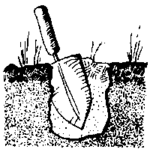
Cathole
Encyclopedia

Human feces
Human feces , also known as a stool, is the waste product of the human digestive system including bacteria. It varies significantly in appearance, according to the state of the digestive system, diet and general health....
. Catholes are frequently used for the purpose of disposing of bowel movements or waste water (such as the water from cleaning the kitchen dishes) by hikers and others engaging in outdoor recreation
Recreation
Recreation is an activity of leisure, leisure being discretionary time. The "need to do something for recreation" is an essential element of human biology and psychology. Recreational activities are often done for enjoyment, amusement, or pleasure and are considered to be "fun"...
.
Catholes must be located at a reasonable distance (at least 60 m) from water sources (rivers, lakes, etc.), to avoid possible bacteria
Bacteria
Bacteria are a large domain of prokaryotic microorganisms. Typically a few micrometres in length, bacteria have a wide range of shapes, ranging from spheres to rods and spirals...
l contamination of water via precipitation, as well as away from trails. For faster feces decomposition, organic soil is preferred over a mineral (sandy) one. It is also recommended to avoid concentration of catholes around campsites. Filled catholes must be covered with a reasonably thick layer of soil, to prevent access by animals, some of which are coprophagous
Coprophagia
Coprophagia or coprophagy is the consumption of feces, from the Greek κόπρος copros and φαγεῖν phagein . Many animal species practice coprophagia as a matter of course; other species do not normally consume feces but may do so under unusual conditions...
.
In some areas, it is not appropriate to dispose of human feces through the use of catholes. For example some areas require special instructions on human waste disposal. In rocky places, with the absence of soil, it is advised to smear feces thinly over rocks that have good sun access for faster sterilization by UV radiation and drying. In larger snow fields, a larger distance (e.g., 200 m) from trails and campsites may be mandated, if the waste is being disposed under snow.

